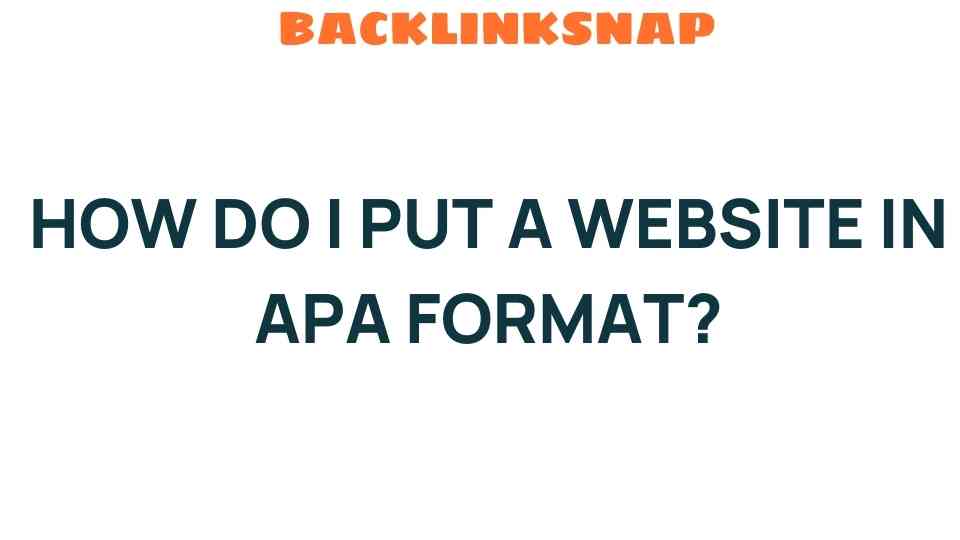Mastering APA Format: How Do I Put a Website in APA Format?
When it comes to academic writing, understanding different citation styles is crucial. One of the most widely used formats in research papers is the APA format (American Psychological Association). This style is essential for students, researchers, and professionals alike, as it not only helps to give credit to original sources but also lends credibility to your work. Among the various sources you may need to cite, websites have become increasingly significant in today’s digital age. So, how do you put a website in APA format? Let’s delve into the details.
Understanding APA Format for Website Citation
APA format has specific formatting guidelines that must be adhered to, especially when referencing websites. The basic structure for citing a webpage in APA format includes the author, the publication date, the title of the webpage, the website name, and the URL. Here’s the general format:
Author, A. A. (Year, Month Date). Title of webpage. Website Name. URL
Let’s break this down for clarity.
Components of Website Citation in APA Format
- Author: This can be an individual or an organization. If no author is available, start with the title of the webpage.
- Publication Date: Include the year, followed by the month and day. If no specific date is available, just use the year.
- Title of Webpage: This should be italicized and in sentence case (only the first word and proper nouns capitalized).
- Website Name: This is the name of the overall website, which should be in plain text.
- URL: Direct link to the webpage should be included without a period at the end.
Examples of Website Citation in APA Format
To give you a clearer picture, let’s look at some examples:
- Smith, J. (2021, April 5). Understanding psychology: An overview. Psychology Today. https://www.psychologytoday.com
- World Health Organization. (2020, March 27). COVID-19 dashboard. WHO. https://covid19.who.int
- Pew Research Center. (2022). Social media use in 2021. https://www.pewresearch.org
These examples illustrate how to format citations correctly. Notice how each component plays a vital role in providing comprehensive information about the source.
Challenges in Referencing Websites
While citing websites in APA format may seem straightforward, several challenges can arise:
- Missing Information: Not all websites provide complete information, such as the author’s name or publication date. In such cases, use “n.d.” for ‘no date’ and start with the title if there’s no author.
- Dynamic Content: Websites are frequently updated, which can lead to discrepancies. Always check the most current version of the webpage before citing it.
- Credibility Issues: Ensure that the website you are citing is credible. Scholarly articles and established organizations are typically more reliable than personal blogs.
Formatting Guidelines in APA Style
Beyond just website citations, APA format has several general formatting guidelines that you should follow in your research papers:
- Font: Use a readable font like 12pt Times New Roman or 11pt Arial.
- Margins: Keep 1-inch margins on all sides.
- Line Spacing: Use double-spacing throughout the document.
- Title Page: Include a title page with the title of your paper, your name, and your institutional affiliation.
- References Page: List all your references on a new page at the end of your paper, formatted with a hanging indent.
Why Citation Matters in Academic Writing
Proper citation is not just a formality—it’s a fundamental aspect of academic integrity. When you cite sources correctly, you demonstrate respect for the work of others, avoid plagiarism, and provide your readers with pathways to verify and explore your sources further. In essence, it bolsters the credibility of your own work.
Common FAQs About APA Format and Website Citation
If there is no author, start with the title of the webpage. For example: Global warming: Facts and information. (n.d.). National Geographic. https://www.nationalgeographic.com
List all authors up to 20. For more than 20 authors, list the first 19, then add an ellipsis (…) followed by the last author’s name.
3. Are there specific formats for different types of websites?
While the general structure applies, certain types of websites (like blogs, forums, or social media) may have unique citation nuances. Always refer back to the APA guidelines for specifics.
4. How do I handle a website that frequently updates its content?
It’s essential to provide the date you accessed the website if the content is likely to change. For example: Retrieved October 1, 2023, from https://www.example.com
5. Can I use websites as sources in academic papers?
Yes, but ensure they are credible and authoritative. Scholarly articles, government sites, and reputable organizations are the best sources.
6. Do I need to include the retrieval date in APA citations?
Generally, you do not need to include retrieval dates unless the content is subject to change over time (e.g., wikis).
Conclusion
Mastering APA format for website citation is an invaluable skill in academic writing. By following the outlined guidelines and understanding the components of website citations, you can enhance the credibility and professionalism of your research papers. Remember, proper citation not only acknowledges the contributions of others but also enriches your academic work. As you navigate through your scholarly articles, keep these principles in mind, and you’ll find that referencing websites becomes second nature. Happy writing!
For further reading on citation styles, consider checking out Purdue OWL for comprehensive resources.
This article is in the category Digital Marketing and created by BacklinkSnap Team




